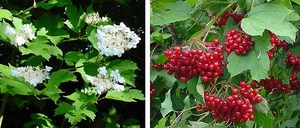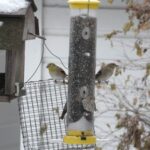This list contains some of the most well known and easy to grow shrubs and trees. They all have something in common besides branches and leaves that provides homes and shelter. These ten shrubs and trees also provide food for the birds and wildlife that will visit them. The fruits and berries from several of these shrubs and trees are favorites of several species of birds.
The following list includes something for almost every region and zone in North America. If replacing or adding a tree or shrub to the landscape is on the “to-do” list anyway, choosing one for the birds is a beautiful addition, as well as beneficial. The more birds attracted to the backyard, the less insect problems during the warm months.
Viburnum:
Viburnum is a shrub that has a large selection of native North American varieties available. Some viburnum shrubs are deciduous and others are evergreen. Several of the deciduous types have colorful fall foliage. The native habitat of viburnum shrubs are very similar to that of the flowering dogwood. The understory of large trees is the ideal location for them where they’ll receive shade to part sun.
They’re excellent grouped together in shrub borders or as a single specimen plant. This shrub makes a great habitat for birds. Several species of birds actually prefer shrubs as shelter and nesting sites instead of trees. The viburnum varieties that produce berries in late summer or fall are also a significant food source for many birds. The large varieties of viburnum can be pruned into a more manageable size.
Height: 2 to 30 feet (many are in the 4 to 6 ft. range)Flowers and fruit: The beautiful white flowers are sometimes fragrant and bloom in spring and last through summer. Some of these shrubs also have showy clusters of beautiful red berries
Best varieties to try: Cranberry viburnum (V. Trilobum) is tough variety. Nannyberry viburnum (V. lentago) produces berries and it also produces sucker plants. Arrowwood viburnum (V. Dentatum) makes a great choice for nesting and shelter.
USDA Zones: 3-8
Holly (Ilex)
Many hollies are evergreen which makes them especially good for wildlife in the winter months. They are favored in the home landscape due to their beautiful deep green leaves which seem to always shine. Hollies are easy to grow and can vary greatly in height and leaf form. There are approximately 20 species that are natives and more than 100 varieties total. They don’t have particular water or sun requirements. Most hollies do great in full sun or part shade and can tolerate drought as well. Several varieties have brightly colored berries that are a favorite food source for many types of birds.
Height: 1.5 to 25 feet or more
Flowers and fruit: Small creamy flowers have a slight honey fragrance loved by bees and the clusters of berries may be bright red, yellow or black.
Best varieties to try: Winterberry (Ilex verticillata ‘Winter Red’) reaches about 9 ft. tall with plenty of showy berries in the winter, Yaupon holly (Ilex vomitoria) is a shrub used for nesting by birds.
Oregon Grapeholly (Mahonia aquifolium):
The Oregon grapeholly is a terrific shrub to provide a safe shelter for birds. The branches are dense with evergreen leaves. These shiny green leaves are prickly at the edges and resemble the leaves of several plants from the large family of Ilex species which is commonly known as holly. The Oregon grapeholly prefers shade in areas where summers are hot. Under these conditions, a woodland setting would suit them perfectly. In a perfect setting, the Mahonia shrub can be invasive. It’s always a good idea to check the local lists of invasive plants before trying something in the landscape for the first time.
Height: 4 to 6 feet
Flowers and fruit: They produce yellow flowers in the winter or early spring which are followed by clusters of tiny berries. These berries do resemble miniature grapes and will be eaten by the birds quickly.
Best varieties to try: Leatherleaf Mahonia (M. Bealei, Zones 5- 9) has blue-green foliage and the best varieties for the south are Mahonia x media cultivars “Charity and ‘Winter Sun’.
USDA Zones: 4- 8
Scarlet Firethorn (Pyracantha coccinea):
The Pyracantha shrub lives up to its common name since it does have thorny branches. This woody shrub’s annoyance for humans that makes it such an excellent shelter for birds. It’s a favorite nesting shrub for many birds. The berries it produces is eaten by several species, including bluebirds. The firethorn is often used as a trained specimen because of its slow growth. It can be grown against the wall of a structure, on a trellis or trained into formal shapes. These shrubs prefer full sun but will tolerate shade. Look for disease- resistant varieties.
Height: 12 to 15 feet
Flowers and fruit: The firethorn has creamy white flowers followed by thick clusters of berries throughout the fall season lasting into winter. The berries are loved by many birds, including bluebirds.
Best varieties: The hardiest varieties include ‘Rutgers” and ‘Yukon Belle’, a dwarf variety called ‘Apache’ only grows to 5 feet tall.
USDA Zones: 5 or 6 to 9
Spicebush (Lindera benzoin)
The spicebush is not only for the birds, but a favorite shrub of butterflies. This early blooming deciduous shrub feeds several varieties of birds on the autumn berries. If you want to entice swallowtail butterflies, then this is a good plant to add to the butterfly garden as well. Not only do the swallowtail butterflies love the flower nectar, but the butterfly larvae feed on the leaves making this a perfect butterfly host shrub. The spicebush gets its name from the spicy scent of the bark and leaves. It’s grows slow in full sun to part shade with moist soil. The berries are only produced on the female plant so the male and female plants are needed for fruit production.
Height: 5 feet tall and about 10 feet wide
Flowers and fruit: Pale yellow flowers in spring with red or orange berries in late summer or fall.
Best varieties: A variety with orange-yellow berries is called ‘Xanthocarpa” and a male pollinator shrub with large flowers is ‘Green Gold’
USDA Zones: 4-9
Flowering Crabapple (Malus)
The flowering crabapple is a small deciduous tree that’s loved by humans as well as birds. The flowers of the crabapple are extremely showy. Bees and butterflies love the flowers. Hummingbirds will also visit the flowers if you live in a zone where the hummers arrive early enough for the crabapple tree’s early spring display. Many flowering crabapple trees also have attractive fall foliage. It prefers full sun.
Height: 15 to 25 feet
Flowers and fruit: The tree blooms in pink, white or red flowers in spring. Some varieties have pink buds which turn to white when fully opened. The fruits will appear in the late summer in red or yellow. The crabapple varieties with the smallest fruits are best for birds.
Best Varieties to try: ‘Donald Wyman” (white flowers), ‘Mary Potter’ (white flowers), ‘Bob White” (dark pink buds turn to white flowers)
USDA Zones: 4-7
Colorado Blue Spruce (Picea pungens f. glauca)
Every yard needs an evergreen for birds and this is a beneficial tree to plant. The tree is a beautiful addition to any landscape and adds the silvery blue evergreen needles that are a great accompaniment for so many plants. Some Colorado blue spruces can grow quite large, so know which size you’re getting to be sure there is ample space for it. Some grow to only 30 feet tall while others reach 60 feet in height. There are also dwarf varieties that only grow to about 15 feet tall. All have an almost perfect pyramidal shape. They also have dense branches. It’s this feature that makes the tree feel secure to birds for nesting and storm shelter.
Height: 30 to 60 feet
Flowers and fruit: Chickadees and Nuthatches eat its seeds. The Colorado blue spruce develops an abundant crop of cones every 2 to 3 years.
Best Varieties to try: ‘Hoopsii” and ‘Thompsen” are tall varieties with the bluest needles, ‘Fat Albert’ is dwarf blue spruce perfect for small yards and “Iseli Foxtail’ is a recommended variety for the south.
USDA Zones: 3-8
Hawthorn (Crataigus)
The berries of the Hawthorn are a favorite food source for many birds. This deciduous tree is also used for nesting or overnight shelter. The spring flowers are popular with butterflies. Hawthorns are members of the rose family and do have thorns up to 2 inches in length along the stems. There is a large number of Hawthorn species with native varieties being the best choice for wildlife. They have attractive orange or bronze fall foliage. Give these trees a sunny location.
Height: 20 to 40 feet
Flowers and fruit: Thick clusters of flowers in spring with orange-red berries that last into winter.
Best varieties to try: ‘Winter King’ has the showiest berries, the cockspur hawthorn ( C. Crus-galli) and Washington hawthorn ( C. Phaenopyrum) are favorites for wildlife.
USDA Zones: 3-8
Serviceberry (Amelanchier)
These are hardy and beautiful deciduous shrub or small trees. They usually have multiple trunks and can grow about as wide as their height. They have a wide range of native habitats throughout the United States. This makes them very adaptable to a wide range of climates, soils and conditions. The serviceberry can adapt to sun or shade and grows naturally at the edge of woodlands. They have bright orange or red fall foliage.
Height: 6 to15 feet
Flowers and fruit: White flowers appear in the spring and the berries that follow will start out red and ripen to black.
Best varieties to try: Cultivars known as A. X grandiflora are crossed with downy serviceberry and are among the showiest in spring and fall. These include ‘Autumn Brilliance’, ‘Ballerina’, and ‘Princess Diana’
USDA Zones: 4-9
Flowering dogwood (Cornus florida):
Dogwood trees are loved for their beautiful spring blooms and manageable size. They are more than a beautiful specimen in the yard or the edge of woodlands. They provide a significant food source for wildlife. The red berries they produce in the autumn are eaten by many species of birds, as well as squirrels and other wildlife. The dogwood tree is also used for shelter. The natural habitat for dogwoods is in the semi shade of larger trees and this is the environment in which they thrive. Their native habitat is the eastern United States from Florida to Maine. The soil would naturally be rich and high in organic material where they naturally grow due to the decomposition of fallen tree leaves.
Height: 20 to 30 feet
Flowers and fruit: White, pink flowers in the spring with red berries in the fall.
Best varieties to try: The green and white variegated leaf of C. florida ‘Variegata”adds interest to the foliage. There is a variety called “Plena” that has double flowers.
USDA Zones: 5-9





